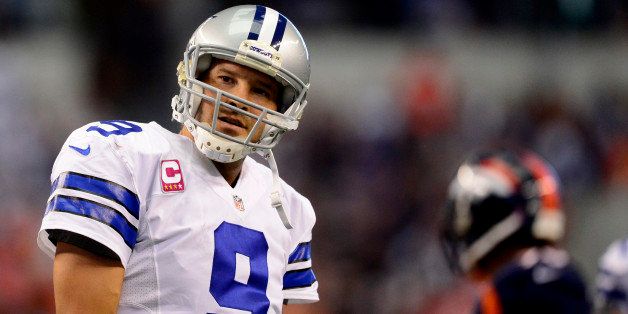
The battle lines were established in a matter of seconds following the NFL’s most electrifying game of the still young 2013 season. The debate—an argument conducted countless times before that will no doubt be waged again—surrounded the sensational performance of oft-maligned Dallas Cowboys quarterback Tony Romo in his team’s 51-48 Week 5 defeat at the hands of Peyton Manning and the undefeated Denver Broncos.
On one side stood the Romo supporters, defending a truly remarkable performance that ranks close to par with anything we’ve witnessed thus far into the season. This position was established to argue those who labeled the 33-year-old signal-caller, to put it bluntly, a “choke artist,” in the wake of Romo’s costly interception with less than three minutes to play that paved the way for Denver’s game-winning 28-yard field goal.
Those who braved the internet firestorm following the game were treated to a variety of opinions—some good, some bad—relating to the quality of Romo’s performance and whether or not the quarterback deserved the dreaded “goat” label for the team’s shortcoming.
As to the side that won the argument, well, this just so happens to be one of those debates in which both parties are correct.
There’s absolutely no denying the fact that Romo’s effort was a sensational display that featured a team-record 506 passing yards, five touchdowns and an out-of-this-world passer rating of 140.0 against the most feared team in the National Football League. Romo’s counterpart, MVP frontrunner Peyton Manning, threw for fewer yards (414) and fewer touchdowns (4), recorded an inferior yards per attempt average (9.9 YPC to Romo’s insane 14.1) and—and this is critical—the exact same amount of interceptions (1).
The only difference is that Manning’s interception came with 14 seconds remaining in the third quarter when Denver was leading 38-33, while Romo’s turnover came on what could have been the game-winning drive with the contest knotted 48-48 late in the fourth quarter.
The problem with this debate is the context in which it was argued. The pro-Romo side was focused on the present—Romo’s performance against Dallas—while the anti-Romo position viewed the fourth quarter mishap within the wider spectrum of the quarterback’s other notable shortcomings—the botched snap at Seattle during the playoffs in 2007 and the three-interception display at Washington in Week 17 last season, to name just two instances. But the problem with the pro-Romo stance—again, while correct in its position that Romo played a terrific game on Sunday—is that it utilizes a gaudy stat line as a defense for what the quarterback’s fat new contract expects him to do.
Win football games.
Through five weeks, with the NFC East in utter shambles, Tony Romo and the Dallas Cowboys are just 2-3 and tied for the divisional lead with a Philadelphia Eagles team that entered the weekend riding a three-game losing streak. One week prior to Romo’s late-game meltdown against the Broncos, the veteran quarterback took a 21-13 lead into halftime at San Diego, only to engineer exactly zero points during a second half that saw the Cowboys eventually lose to the Chargers, 30-21.
For a second-year quarterback like Andrew Luck—who came back to beat the undefeated Seahawks on Sunday—such a mistake would be chalked up to the learning process. But that excuse doesn’t apply to a player who resides in the rarefied air of lucrative NFL quarterback contracts.
Including Romo, there are a grand total of six quarterbacks with an average yearly salary of $18 million or greater. Four of those quarterbacks, Aaron Rodgers ($22.0 million), Joe Flacco ($20.1 million), Drew Brees ($20.0 million) and Peyton Manning ($19.2 million), all own Super Bowl rings. The other, Falcons signal-caller Matt Ryan, has been to the postseason more times (four) in fewer years as a starting quarterback (five) than Romo (three trips in seven years).
The six-year contract extension worth $108 million that Romo signed this past March launched the ten-year veteran into the elite class of quarterback compensation, without the requisite winning resume or postseason hardware. Since taking over as the starting quarterback for the Dallas Cowboys in 2006, Tony Romo has won exactly one postseason game (2010) in four attempts.
The contract wasn’t negotiated as a reward for past results or as an expectation for 500-yard passing efforts. It was given with both the belief and expectation that Romo would lead the Dallas Cowboys to a Super Bowl title.
If you’re still in search of a goat to carry the blame for Dallas’ Week 5 loss, look no further than a defensive unit that surrendered a staggering 517 total yards and 51 points. Tony Romo isn’t the answer to the question asking why the Cowboys lost to the Broncos on Sunday, but his failure to lead the offense down the field inside of three minutes is one of the reasons why the team didn’t win.
Sunday’s postgame debate has an answer, but it also resurrected the question many of us have been asking for the last few years.
In a big spot with the game on the line, is Tony Romo capable of delivering in the clutch?
Hit me up on Twitter: @JoeFortenbaugh
